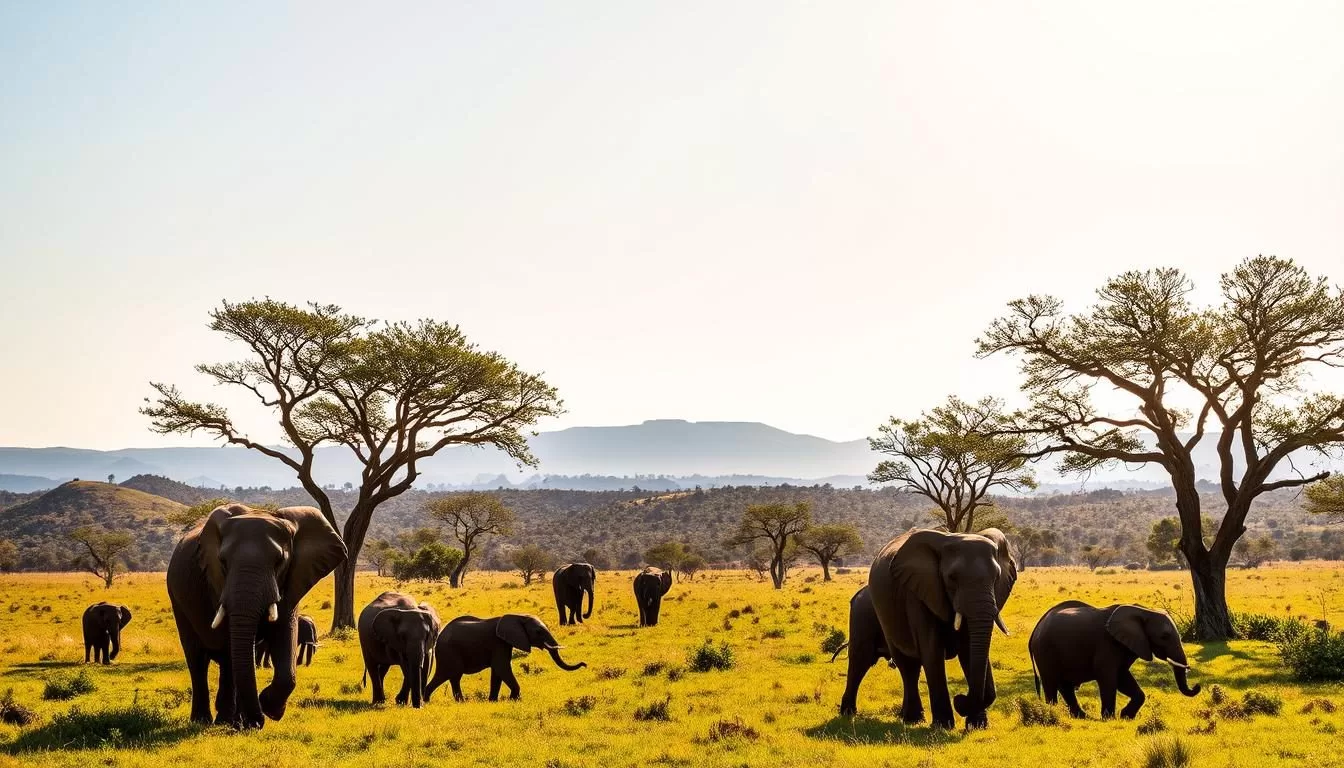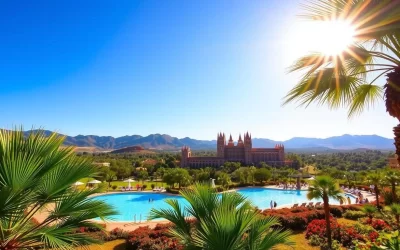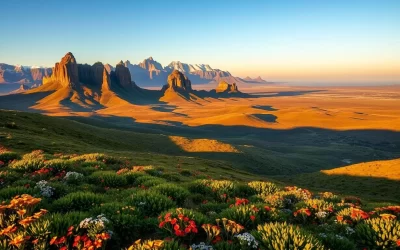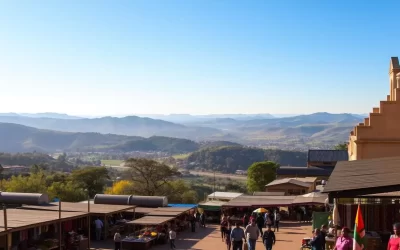Imagine being in the midst of a vast, diverse wildlife sanctuary, where the majestic elephants roam free. You’re about to embark on an unforgettable journey through Addo Elephant National Park, a haven that promises an unparalleled safari experience.
This incredible park, founded in 1931, has grown to become one of South Africa’s most treasured conservation areas, boasting over 600 elephants and a wide variety of other animals. As you explore this vast reserve, you’ll have the unique opportunity to witness the “Big Seven” in their natural habitat.
With its diverse ecosystems, ranging from the mountains of the Karoo to the largest dune fields at Woody Cape, Addo Elephant National Park is a true gem. Get ready to uncover the top picks for your visit, from the best times for wildlife viewing to insider tips on making your trip truly unforgettable.
Discovering South Africa’s Third-Largest National Park
You’ll find an incredible array of wildlife at Addo Elephant National Park, a testament to South Africa’s commitment to conservation. As the third-largest national park in South Africa, it offers a unique experience for visitors.
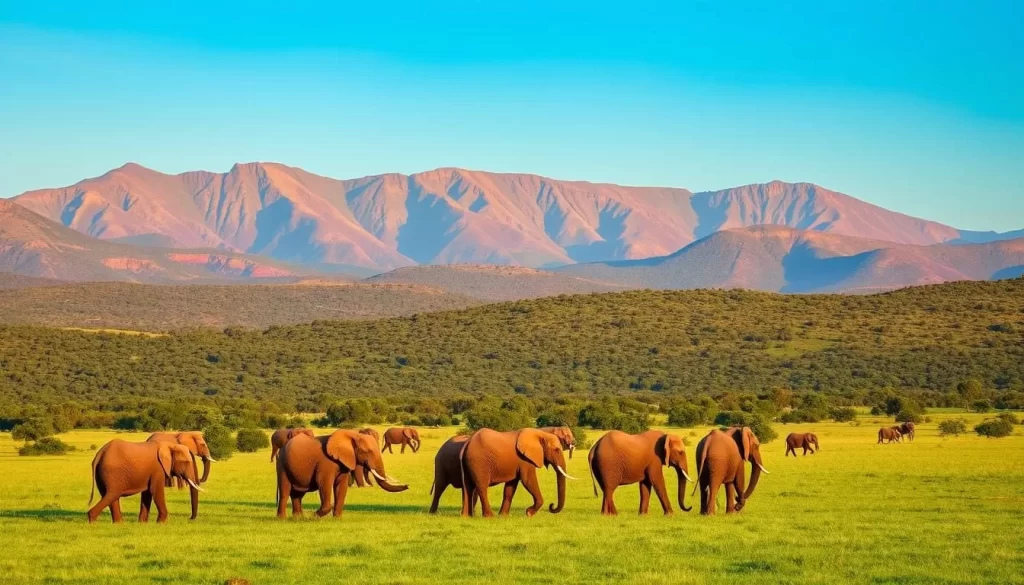
From Humble Beginnings to Conservation Success
Addo Elephant National Park has evolved significantly since its inception, transforming into a thriving conservation area. Initially established to protect the Addo elephant, it has expanded to safeguard various ecosystems, now boasting five distinct biomes. This expansion has enabled a wide range of animals to flourish.
The park’s growth is a testament to successful conservation efforts, creating a haven for wildlife. Its diverse landscapes support numerous species, making it a significant conservation success story.
The Only Park Home to the “Big7”
What sets Addo Elephant National Park apart is its distinction as the only conservation area in the world where you can encounter the complete “Big7”: lions, leopards, black rhinos, cape buffalos, the majestic Addo elephant, great white sharks, and southern right whales. This unique feature makes it a compelling destination for wildlife enthusiasts.
- The park is home to a diverse array of wildlife, including the “Big7” and numerous other species.
- Its marine section protects the waters around Bird Island and St. Croix Island, home to the largest African penguin breeding colony.
- Beyond the “Big7,” the park shelters spotted hyenas, zebras, various antelope species, and over 400 bird species.
When to Visit Addo Elephant National Park
Planning a trip to Addo Elephant National Park requires understanding the best times to visit. The park, located near Cape Town, South Africa, experiences a Mediterranean climate, characterized by hot, dry summers and cool, wet winters.
Best Seasons for Wildlife Viewing
The best time for wildlife viewing in the park is from September to April, when the weather is generally favorable. During this period, the mild temperatures make it easier to spot animals. The transitional seasons of spring (September-November) and autumn (March-May) are particularly good, offering pleasant temperatures and excellent wildlife viewing opportunities.
Weather Considerations
The area around Addo Elephant National Park receives an average of 450mm of rainfall per year, with most precipitation occurring during the winter months. Summer visitors should be prepared for hot days, with temperatures sometimes exceeding 30°C (86°F). The coastal influence moderates the temperature, making early morning and late afternoon game drives the most comfortable times.
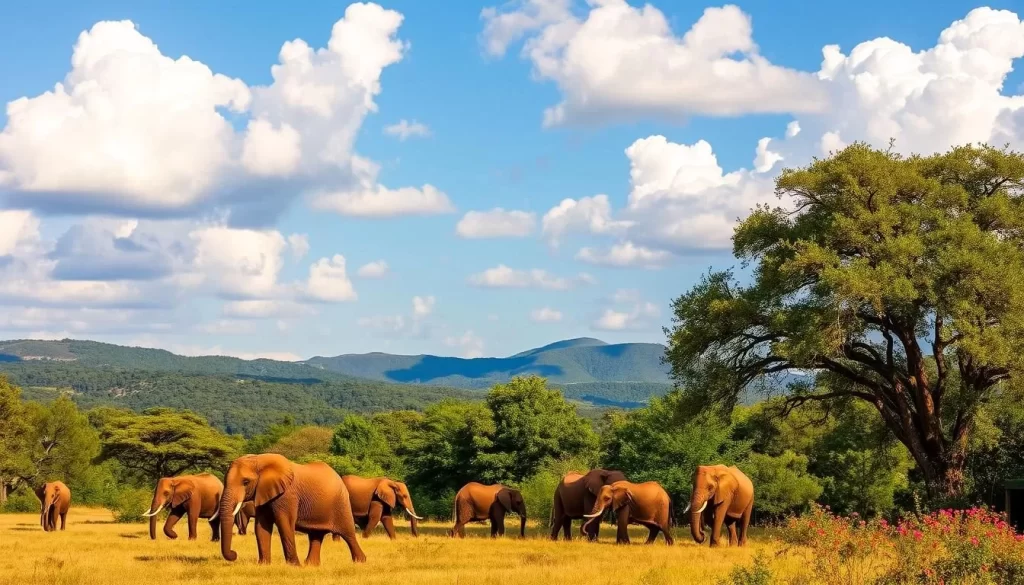
How to Get to Addo Elephant Park
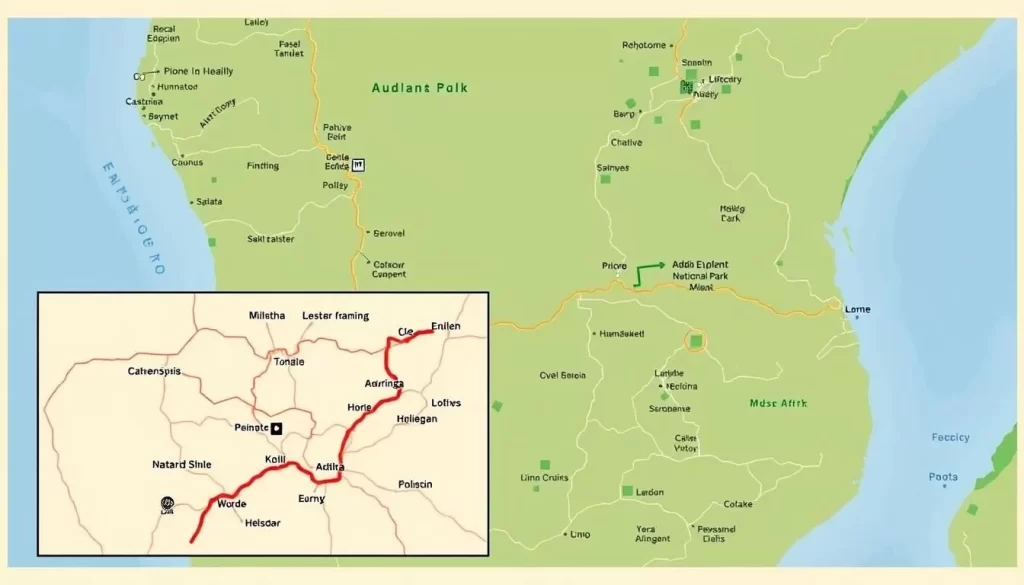
If you’re wondering how to reach Addo Elephant National Park, we’ve got you covered. Located near the town of Addo, the park is accessible by various means, ensuring that your journey is as smooth as possible.
From Port Elizabeth
The closest major city to Addo Elephant National Park is Port Elizabeth. You can rent a car or take a taxi/private transfer from Port Elizabeth to the park. The drive is approximately 45 minutes, making it a convenient day trip or the start of a longer safari adventure.
From Cape Town and Johannesburg
For those traveling from Cape Town or Johannesburg, the best option is to fly into Port Elizabeth Airport. From there, you can rent a car or arrange for a private transfer to the park. Alternatively, numerous tour operators offer guided tours that include transportation from these major cities.
Transportation Options
The best way to get to Addo Elephant National Park is by rental car, offering flexibility for exploring the park. Most roads within the main section are accessible to standard 2WD vehicles. For those uncomfortable driving in South Africa, numerous tour operators offer guided day trips and multi-day safari packages. Public transportation is limited, but shuttle services and taxis are available, albeit at a higher cost for multi-day visits.
Wildlife Encounters: What Animals You’ll See
Visitors to Addo Elephant National Park can expect to see a variety of wildlife, from the iconic Big7 to numerous other species that inhabit the area. The park is a haven for wildlife enthusiasts, with its diverse fauna and flora making it an unforgettable experience.
The Magnificent Elephants of Addo
The park is perhaps most famous for its majestic elephants. With a large population of these gentle giants, Addo Elephant National Park provides a unique opportunity to observe them in their natural habitat. The elephants here are a testament to the park’s conservation efforts, having grown significantly in number since the park’s establishment.
Beyond Elephants: The Big7 and More
In addition to elephants, the park is home to the Big7: lion, leopard, buffalo, rhino (both black and white), and the elusive Cape buffalo and leopard. The park’s diverse ecosystems support a wide range of other animals, including various antelope species and predators.
Rare and Endemic Species
The park is also a sanctuary for several rare and endemic species. For instance, the Addo flightless dung beetle is a unique insect that has lost its ability to fly and plays a crucial role in the ecosystem by processing elephant dung. Other endemic species include the Addo elephant shrew, a small mammal that is native to the Eastern Cape region.
Some other notable species found in the park include over 100 species of reptiles, such as the endangered geometric tortoise, and a diverse range of plant species, including ancient cycads and numerous succulents. The marine section of the park is also home to Indo-Pacific bottlenose dolphins, humpback whales, and the endangered African penguin, showcasing the area’s rich biodiversity.
Addo Elephant National Park, South Africa: Best Things to Do – Top Picks
Your adventure in Addo Elephant National Park is filled with diverse activities tailored to different interests. Whether you’re an avid wildlife enthusiast or just looking for a unique experience, Addo Elephant Park has something for everyone. From self-drive safaris to guided tours and hiking trails, the park offers a range of exciting ways to explore its natural beauty.
Self-Drive Safaris
Embark on a self-drive safari through Addo Elephant National Park for an intimate wildlife experience. With well-marked trails and comprehensive guides, you can navigate the park at your own pace. This option allows you to spend as much time as you like observing the animals and taking in the breathtaking scenery.
Guided Game Drives
For a more immersive experience, join a guided game drive led by knowledgeable rangers. They’ll help you spot a wide range of wildlife, from the Big 7 to smaller, more elusive creatures. Guided tours offer insights into the park’s ecosystem and conservation efforts, enhancing your understanding and appreciation of the natural world.
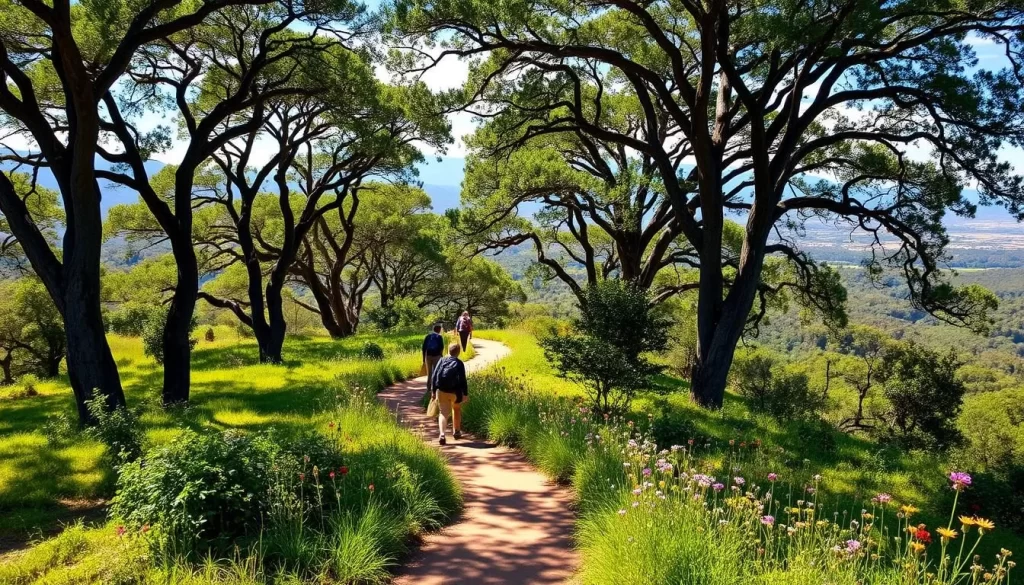
Hiking Trails
Addo Elephant National Park boasts several hiking trails suitable for different skill levels. The Zuurberg hiking trails offer panoramic views and the chance to explore indigenous forests. For a coastal experience, the Alexandria Hiking Trail takes you through ancient dune forests and along pristine beaches. Each trail provides a unique perspective on the park’s diverse landscapes and wildlife.
Unique Experiences in Addo
For those seeking adventure, Addo Elephant National Park is a treasure trove of unique activities that will enhance your safari experience.
Underground Viewing Hide at Main Camp
The Underground Viewing Hide at Main Camp offers a unique perspective on wildlife viewing. You can observe animals without being seen, creating an immersive experience.
Horseback Safaris
Explore the wilderness on horseback, getting up close to the park’s wildlife. This unique experience allows you to traverse the terrain in a more intimate way.
Marine Eco-Tours
Marine eco-tours offer a different dimension to your safari experience. You’ll explore the marine section of the park, spotting African penguins, southern right whales, and Cape gannets. The park’s marine reserve is home to the world’s largest breeding colony of Cape gannets, with over 160,000 birds.
Best Waterholes for Wildlife Viewing
The waterholes in Addo Elephant Park are a major draw for wildlife enthusiasts, offering a chance to see a variety of animals in their natural habitat. These waterholes are particularly attractive during the dry season when animals congregate around these water sources.
Main Camp Waterhole
The Main Camp Waterhole is a popular spot for viewing large herds of elephants. It’s an ideal location for spotting other wildlife, including buffalo, zebra, and various antelope species. Visiting during early morning or late afternoon yields the best results.
Hapoor Dam and Carol’s Rest
Hapoor Dam is renowned for its elephant sightings, with up to 100 individuals gathering at times. Named after a famous elephant bull, this waterhole has a spacious viewing area. Carol’s Rest, located about 6 km from Zuurkop Lookout Point on the Gorah Loop, offers excellent photographic opportunities due to its open surroundings and favorable light conditions. You can expect to see not just elephants, but also zebra, warthogs, and more.
- Hapoor Dam and Carol’s Rest are among the top recommendations for wildlife viewing.
- These waterholes attract a diverse range of wildlife, making them excellent spots for game viewing.
- Visiting during the dry season (June-September) increases your chances of spotting a wide variety of animals.
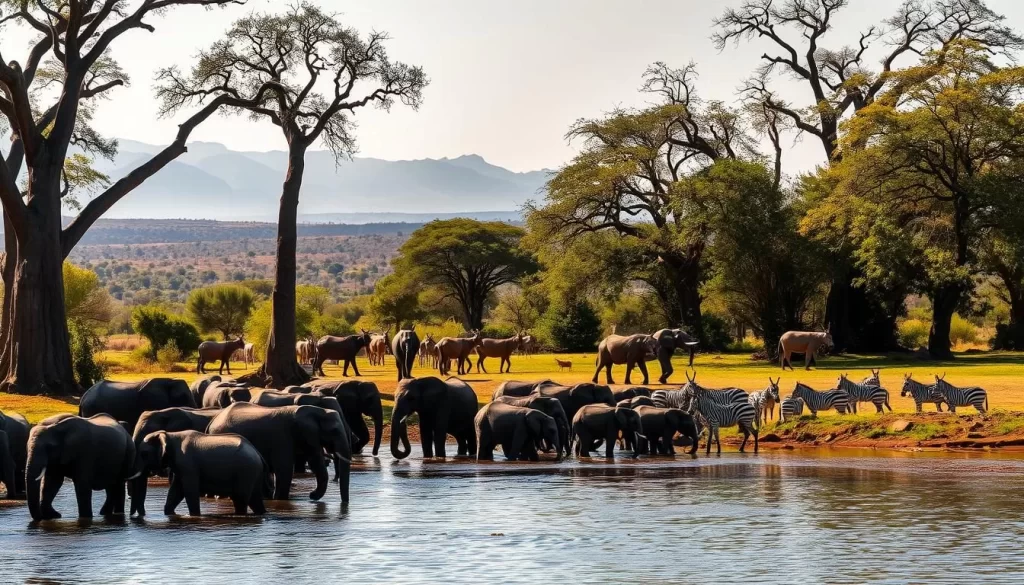
Where to Stay In and Around Addo
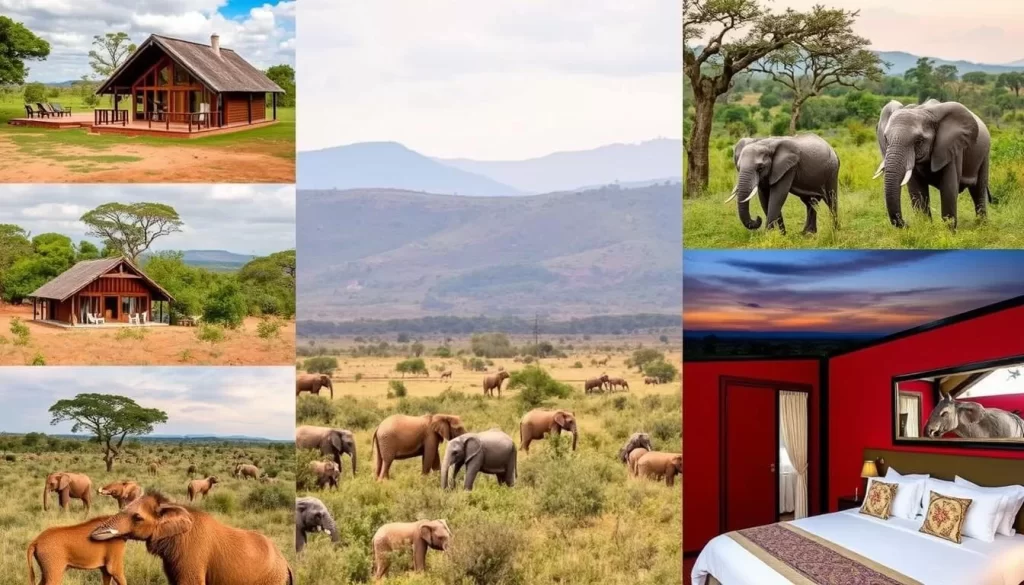
When planning your trip to Addo Elephant National Park, choosing the right accommodation is crucial for a memorable experience. The park and its surroundings offer a variety of options to cater to different needs and preferences.
Inside the Park: Rest Camps and Lodges
For those who wish to stay within the park, Addo Elephant National Park offers rest camps and lodges that provide an immersive experience. You can stay in environmentally friendly en-suite luxury units at Addo Elephant Safari Lodge, which offers elephant back safaris through the valley bushveld and forest. These luxury units come with private decks, spa baths, and wood-burning fireplaces, enhancing your wildlife experience.
Other options inside the park provide a unique and intimate connection with nature, allowing you to be closer to the wildlife and enjoy the serene environment.
Nearby Accommodations
If you prefer to stay outside the park, the towns of Addo and Sunland offer numerous accommodation options, ranging from affordable guesthouses to luxury lodges on private game reserves. Hitgeheim Country Lodge is a stylish option with chalets featuring extra-length beds, outdoor showers, and private wooden decks overlooking the Sundays River Valley.
For a more adventurous stay, AfriCamps Addo offers boutique glamping tents with easy access to mountain biking, trail running, and hiking routes. Alternatively, Broadlands Country House provides a colonial farmhouse experience on a working citrus farm, with spacious rooms and self-contained cottages overlooking a lake.
Essential Tips for Your Addo Visit
To ensure a smooth and enjoyable visit to Addo Elephant National Park, consider these essential tips. Planning ahead will help you make the most of your time in this incredible wildlife sanctuary.
What to Pack
When preparing for your visit to Addo Elephant National Park, it’s crucial to pack wisely. Here are some essentials to include:
- Comfortable clothing and sturdy shoes for outdoor activities
- Sun protection, including sunscreen, a hat, and sunglasses
- Insect repellent to keep bugs at bay
- A camera with a good zoom lens to capture wildlife moments
- Binoculars for a closer look at distant animals
Checking the weather forecast before your trip will also help you prepare accordingly.
| Item | Importance | Notes |
|---|---|---|
| Comfortable clothing | High | For self-drive safaris and walking trails |
| Sun protection | High | Sunscreen, hat, and sunglasses |
| Insect repellent | Medium | For bug protection |
Park Rules and Safety
Safety is paramount when visiting Addo Elephant National Park. To ensure a safe and enjoyable experience, follow these guidelines:
- Always remain in your vehicle except at designated areas
- Maintain a safe distance from wildlife, especially elephants
- Observe the park’s speed limits to avoid accidents
- Be mindful of the park’s unique creatures, like the Addo flightless dung beetles
By following these rules, you’ll contribute to the conservation of the park’s wildlife and enjoy a memorable visit.
Conclusion: Why Addo Elephant National Park Should Be on Your Bucket List
South Africa’s Addo Elephant National Park is a conservation success story and a wildlife enthusiast’s paradise, making it a top bucket-list destination. As the only conservation area in the world where you can encounter the complete “Big7,” it offers an unparalleled safari experience.
The park’s remarkable recovery from just 11 elephants in 1931 to over 600 today is a testament to conservation efforts. With diverse ecosystems, including mountain fynbos and marine habitats, Addo Elephant National Park in South Africa caters to all, from families to experienced wildlife enthusiasts. Whether you’re looking for luxury or budget-friendly options, this national park has something for everyone, making it a must-visit destination.
